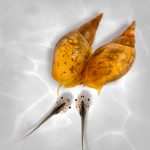Snail shells offer clue in unravelling common origins of body asymmetry

An international team of researchers has discovered a gene in snails that determines whether their shells twist clockwise or anti-clockwise – and could offer clues to how the same gene affects body asymmetry in other animals including humans. The research, published in the journal Current Biology is an important step in understanding how our organs are placed asymmetrically within the body and why this process can sometimes go wrong when some or all of the major internal organs are reversed or mirrored from their normal placement in the body.
Dr. Angus Davison, an expert in evolutionary genetics at the University of Nottingham, led the international research project with involvement from scientists at the University of Edinburgh, UK, University of Göttingen, Germany and Tufts University, USA. Using snails that naturally differ in how their shells twist, Davison and his colleagues were able to identify a gene that controls whether snail shells twist clockwise or anticlockwise. The gene makes a protein called formin, which is involved in making the cell scaffold. A defect in formin means that the whole snail is ‘reversed’, a mirror image of others in the same species.
“While animals tend to be outwardly symmetrical in appearance, they are almost all asymmetrical inside. It is has not been clear if asymmetry is an ancient feature, or something that has evolved several times. By identifying a single evolutionary conserved protein that controls asymmetry in both snails and frogs, we have shown that body asymmetry in most animals, including humans, likely arises from a highly conserved, intrinsic asymmetry of the cells in the early embryo. This research helps to unify our understanding of asymmetry across animals.”, says Dr. Davison.
The scientists first mapped the location of the gene that defines mirror image development in snails, then used genome sequencing technologies to find the mutation in the formin gene that makes snails develop as an anti-clockwise coiling mirror image. Professor Mark Blaxter, leader of the genome sequencing effort in Edinburgh, UK, explains: “We were able to use cutting-edge DNA sequencing and computer analyses to not only sequence the genome of the pond snail very rapidly, but this then enabled Angus to identify the tiny change (one letter in the one billion of the snails’ genome) that causes the switch from clockwise to anti-clockwise. The combination of traditional genetics and developmental biology with the new genomics tools has delivered stunning results.”
To verify the association, the teams mapped where the formin gene was active – in just the right cells in early embryos – and used an anti-formin drug treatment to partially convert normal ‘dextral’ snails (clockwise twist) to mirror image ‘sinistral’ embryos (anti-clockwise). Professor Daniel Jackson, University of Göttingen, Germany, said: “Contrary to what was expected, we were surprised to find that asymmetry is present in the very early embryo, from the two-cell stage onwards. By visualising the asymmetric activity of the formin gene in these early embryos, we were provided with stunning supporting evidence of the role the formin gene plays in this evolutionarily ancient process.”
To understand the link with human development, collaborating scientists in the USA used experiments in the frog to successfully show that the gene has a similar function in the early development of vertebrates. Professor Mike Levin, Tufts University, USA, an expert in asymmetry research, said: “It is extremely exciting to discover that snails and vertebrates use some of the same internal cell components to establish their left-right axis. This very wide evolutionary conservation between snails and frogs underscores the ancient origin of body-wide asymmetry in the molecular events taking place in early embryonic cells.”
The researchers believe that their results provide strong evidence to suggest that this same molecule is likely to be among the earliest ‘symmetry breaking’ components across all Bilateria – animals which have a body-plan with one central axis of symmetry. Both snail and frog embryos derive asymmetry from formin-mediated events occurring inside cells at very early stages of their development. Asymmetry, they argue, is probably an ancient property of cells, which could be traced back to the common ancestor of all Bilaterian animals.
Dr. Angus Davison added: “The ‘switch’ from clockwise to counter-clockwise snails was one of the earliest inherited markers to be properly described, dating back to the 1920s, but the identity of the gene involved has remained unknown ever since. While living in Japan in 2001, I noticed that the snails around me were the ‘wrong’ kind (anti-clockwise coiling). Ever since then I have wanted to find the gene. After securing funding from the BBSRC, we used new DNA sequencing technologies to find the gene in only three and a half years. This work ‘solves’ a longstanding genetic puzzle, but also shows how work on lesser known laboratory animals can be used with new technologies to help understand aspects of our own development.”
The research was principally funded by the Biotechnology and Biological Sciences Research Council (BBSRC) and also involved academics the Welcome Trust Sanger Institute in the UK, Ghent University in Belgium, and Tohoku University in Japan.
Original publication: Angus Davison et al. Formin is associated with left-right asymmetry in the pond snail and the frog. Current Biology. Doi: 10.1016/j.cub.2015.12.071
